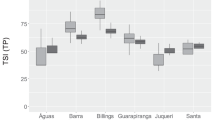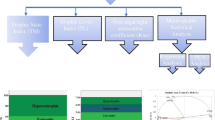Abstract
Trophic parameters including total nitrogen (TN), total phosphorus (TP), Secchi depth (SD), and chlorophyll-a (CHL) were analyzed to evaluate how the Asian monsoon influences the trophicstate of the Taechung Reservoir, Korea. By using conventional criteria, the trophic state of this system ranged from mesotrophic to hypertrophic with spatial and seasonal variationsdepending on landuse pattern and flow regime. Based on TP, CHL, and transparency, the overall trophic state declined from the headwaters to the dam. However, based on TN, the entire reservoir was hypereutrophic thoughout the year. Comparing nutrients and CHL as trophic parameters, large disparities of the trophic state have been observed in the headwaters during intensive monsoon. The trophic state was much greater when assessments were based on nutrients instead of CHL, indicating apotential trophic deviation. Using Carlson's (1990) twodimensional approach, deviations of the Trophic State Index(TSI), based on the relation between TSI (CHL) minus TSI(TP), and TSI (CHL) minus TSI (SD) during the intensivemonsoon indicated that factors other than phosphorus limitedalgal growth, and that non-algal particles affect lightattenuation. These findings were supported by high non-volatilesuspended solids (NVSS), short water residence time, and low CHL:TP ratios during monsoon. Such deviations, however, did not occur during weak monsoon. The trophic disparity during theintensive monsoon was considered to be a result of the shortwater retention time and reduced light availability throughdominance of inorganic suspended solids. Under these circumstances, trophic state assessments based only on nutrientloading may not be a useful indicator for water management.
Similar content being viewed by others
References
A.P.H.A: 1985, Standard Methods for the Examination of Water and Waste Water, 16th ed. New York, American Public Health Association, pp. 874-1133.
An, K-G. and Jones, J. R.: 2000, ‘Temporal and spatial patterns in ionic salinity and suspended solids in a reservoir influenced by the Asian monsoon’ Hydrobiol. 436, 179-189.
Carlson, R. E.: 1977, ‘A trophic state index for lake’ Limnol. Oceanogr. 22, 361-369.
Carlson, R. E.: 1991, Expanding the Trophic State Concept to Identify Non-nutrient Limited Lakes and Reservoirs, Enhancing the States's Lake Management Programs, pp. 59-71.
Cowen, W. F. and Lee, G. F.: 1976, ‘Phosphorus availability materials transported by urban run off’ J. Wat. Pollut. Con. Fed. 48, 580-590.
Crumpton, W. G., Isenhart, T. M. and Mitchell, P. D.: 1992, ‘Nitrate and organic N analyses with second-derivative spectroscopy’ Limnol. Oceanogr. 37, 907-913.
Cunningham, F. K.: 1979, ‘Biological Availability of Phosphorus in the Lake of the Ozarks’ M. S. Thesis, Department of Fisheries and Wildlife Science, University of Missouri-Columbia, Columbia, MO, U.S.A.
Duarte, C. M. and Kalff, J.: 1989, ‘The influence of catchment geology and lake depth on phytoplankton biomass’ Arch. Hydrobiol. 115, 27-40.
Havens, K. E., Hanlon, C. and James, R. T.: 1995, ‘Seasonal and spatial variation in algal bloom frequency in Lake Okeechobee, Florida, U.S.A’ Lake and Reserv. Manage. 10, 139-148.
Havens, K. E.: 1994, ‘Seasonal and spatial variation in nutrient limitation in a shallow sub-tropical lake (lake Okeechobee, Florida) as evidenced by trophic state index deviations’ Arch. Hydrobiol. 131, 39-53.
Havens, K. E.: 1995, ‘Secondary nitrogen limitation in a subtropical lake impacted by non-point source agricural pollution’ Env. Pollut. 89, 241-246.
Havens, K. E.: 2000, ‘UsingTrophic State Index (TSI) values to draw inferences regarding phytoplankton limiting factors and seston composition from routine water quality monitoring data’ Korean J. Limnol. 33, 187-196.
Hoyer, M. W. and Jones, J. R.: 1983, ‘Factors affecting the relation between phosphorus and chlorophyll a in midwestern reservoirs’ Can. J. Fish. Aquat. Sci. 40, 192-541.
Jones, J. R. and Knowlton, M. F.: 1993, ‘Limnology of Missouri reservoirs: An anlysis of regional patterns’ Lake and Reserv. Manage. 8, 17-30.
Kennedy, R. H., Thornton, K. W. and Ford, D.: 1985, Characterization of the Reservoir Ecosystem, in D. Gunnison (ed.), Microbial Processes in Reservoirs, Dr. W. Junk Publishers, Boston, MA, U.S.A.
Kennedy, R. H. and Walker, W.W.: 1990, ‘Reservoir Nutrient Dynamics’ Chapter 5, in Thornton, K. W. et al. (ed.): Reservoir Limnology: Ecological Perspectives, John Wiley and Sons, New York.
Kimmel, B. L., Lind, O. T. and Paulson, L. J.: 1990, ‘Reservoir Primary Production’ in Thornton et al. (ed), Reservoir Limnology-Ecological Perspectives, Wiley Interscience, pp. 133-199.
Knowlton, M. F. and Jones, J. R.: 1995, ‘Temporal and spatial dynamics of suspended sediment, nutrients, and algal biomass in Mark Twain Lake, Missouri’ Arch. Hydrobiol. 135, 145-178.
Kratzer, C. R. and Brezonik, P. L.: 1981, ‘A Carlson-type trophic state index for Nitrogen in Florida lakes’ Water Res. Bull. 17, 713-715.
Lind, O. T., Terrel, T. T. and Kimmel, B. L.: 1993, ‘Problems in Reservoir Trophic-State Classi-fication and Implications for Reservoir Management’ in J. G. Straskraba et al. (eds), Comparative Reservoir Limnology and Water Quality Management, Kluwer Academic Publishers, Netherlands, pp. 57-67.
Marzolf, G. R. and Osborne, J. A.: 1972, ‘Primary production in a Great Plains reservoir’ Verh. Int. Ver. Theor. Angew Limnol. 18, 126-133.
Morris, D. P. and Lewis, W. M.: 1988, ‘Phytoplankton nutrient limitation in Colorado mountain lakes’ Fresh. Biol. 20, 315-327.
Nurnberg, G. K.: 1996, ‘Trophic state of clear and colored, soft-and hardwater lakes with special consideration of nutrients, anoxia, phytoplankton and fish’ Lake and Reserv. Manage. 12, 432-447.
Prepas, E. E. and Rigler, F. A.: 1982, ‘Improvements in qualifying the phosphorus concentration in lake water’ Can. J. Fish. Aquat. Sci. 39, 822-829.
Rawson, D. S.: 1955, ‘Morphometry as a dominant factor in the productivity of large lakes’ Verh. Int. Ver. Theor. Angew. Limnol. 12, 164-175.
Sartory, D. P. and Grobbelaar, J. U.: 1984, ‘Extraction of chlorophyll-a from freshwater phytoplankton for spectrophotometric analysis’ Hydrobiol. 114, 177-187.
Soballe, D. M. and Threlkeld, S. T.: 1985, ‘Advection, phytoplankton biomass, and nutrient transformation in a rapidly flushed impoundment’ Arch. Hydrobiol. 105, 187-203.
Soballe, D. M. and Kimmel, B. L.: 1987, ‘A large-scale comparison of factors influencing phytoplankton abundance in rivers, lakes, and impoundments’ Ecology 68, 1943-1954.
Vollenweider, R. A.: 1968, The Scientific Basis of Lake and Stream Eutrophication, with Particular Reference to Phosphorus and Nitrogen as Factors in Eutrophication, OECD, Paris. Tech. Rep. DAS/CSI/68.27.
Vollenweider, R. A.: 1976. ‘Advances in defining critical loading Levels for phosphorus in lake eutrophication’ Mem. 1st. Ital. Idrobiol. 33, 53-83.
Vollenweider, R. A.: 1990. ‘Eutrophication: conventional and non-conventional considerations and currents on selected topics’ Mem. Ital. Idrobiol. 47, 77-134.
Walker, W. Jr.: 1982. ‘An empirical analysis of phosphorus, nitrogen, turbidity effects on reservoir chlorophyll-a levels’ Can. Water Resour. J. 7, 88-107.
Wetzel, R. G.: 1983,Limnology, W. B. Saunders Co., Philadelphia, PA. pp. 767.
Author information
Authors and Affiliations
Corresponding author
Rights and permissions
About this article
Cite this article
An, KG., Park, S.S. Influence of Seasonal Monsoon on the Trophic State Deviation in an Asian Reservoir. Water, Air, & Soil Pollution 145, 267–287 (2003). https://doi.org/10.1023/A:1023688819724
Issue Date:
DOI: https://doi.org/10.1023/A:1023688819724




